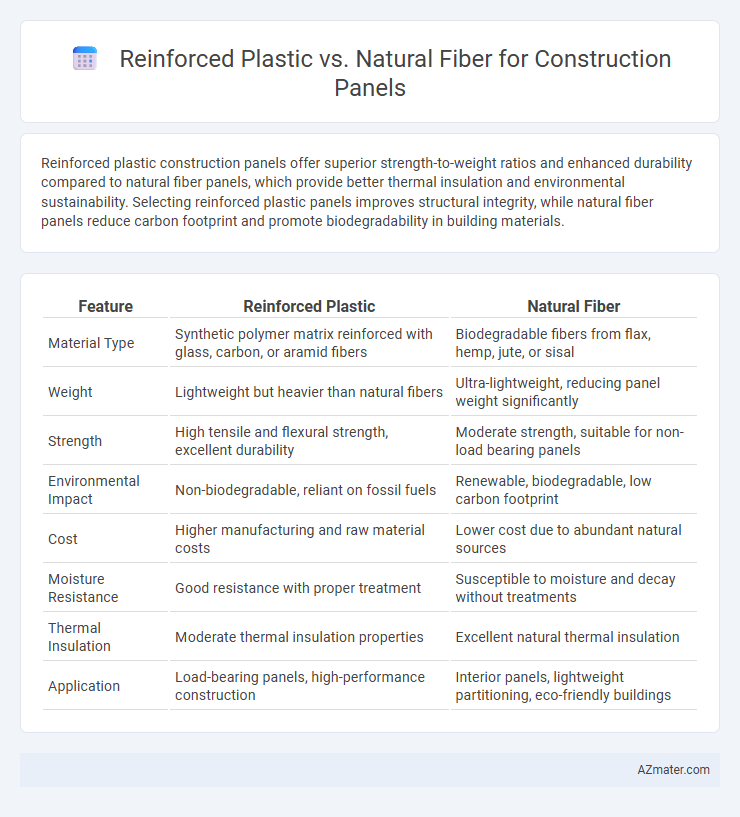Reinforced plastic construction panels offer superior strength-to-weight ratios and enhanced durability compared to natural fiber panels, which provide better thermal insulation and environmental sustainability. Selecting reinforced plastic panels improves structural integrity, while natural fiber panels reduce carbon footprint and promote biodegradability in building materials.
Table of Comparison
| Feature | Reinforced Plastic | Natural Fiber |
|---|---|---|
| Material Type | Synthetic polymer matrix reinforced with glass, carbon, or aramid fibers | Biodegradable fibers from flax, hemp, jute, or sisal |
| Weight | Lightweight but heavier than natural fibers | Ultra-lightweight, reducing panel weight significantly |
| Strength | High tensile and flexural strength, excellent durability | Moderate strength, suitable for non-load bearing panels |
| Environmental Impact | Non-biodegradable, reliant on fossil fuels | Renewable, biodegradable, low carbon footprint |
| Cost | Higher manufacturing and raw material costs | Lower cost due to abundant natural sources |
| Moisture Resistance | Good resistance with proper treatment | Susceptible to moisture and decay without treatments |
| Thermal Insulation | Moderate thermal insulation properties | Excellent natural thermal insulation |
| Application | Load-bearing panels, high-performance construction | Interior panels, lightweight partitioning, eco-friendly buildings |
Introduction to Construction Panel Materials
Construction panels are essential components in modern building systems, offering structural support and durability. Reinforced plastic panels, composed of polymers integrated with fiberglass or carbon fibers, provide high strength-to-weight ratios, moisture resistance, and enhanced longevity. Natural fiber panels, made from materials like hemp, flax, or jute combined with bio-resins, offer sustainable alternatives with benefits in thermal insulation and reduced environmental impact.
Overview of Reinforced Plastic Panels
Reinforced plastic panels in construction combine polymer matrices with materials such as glass or carbon fibers to enhance strength, durability, and resistance to moisture and chemicals. These panels offer superior structural integrity and long-term performance compared to natural fiber alternatives, making them ideal for demanding environments and load-bearing applications. Their lightweight nature and ease of fabrication contribute to faster installation and reduced overall construction costs.
Overview of Natural Fiber Panels
Natural fiber panels in construction utilize materials such as hemp, flax, jute, and kenaf, offering lightweight and sustainable alternatives to traditional reinforced plastic panels. These panels exhibit excellent thermal insulation, biodegradability, and reduced environmental impact, making them ideal for eco-friendly building applications. Despite lower mechanical strength compared to synthetic composites, innovations in fiber treatment and hybridization are enhancing their durability and moisture resistance, expanding their use in structural and non-structural panels.
Mechanical Strength Comparison
Reinforced plastic panels exhibit higher tensile and flexural strength compared to natural fiber panels, making them more suitable for load-bearing applications. Natural fiber panels offer competitive impact resistance and improved ductility, but their mechanical strength is generally lower due to fiber-matrix interfacial bonding limitations. Reinforced plastics also demonstrate superior durability under environmental stress, contributing to enhanced structural performance in construction.
Durability and Weather Resistance
Reinforced plastic construction panels exhibit superior durability and weather resistance due to their synthetic composition, which resists moisture, UV radiation, and temperature fluctuations more effectively than natural fiber alternatives. Natural fiber panels, while eco-friendly and biodegradable, are prone to degradation from prolonged exposure to moisture, pests, and ultraviolet light, leading to reduced structural integrity over time. The enhanced longevity and low maintenance requirements of reinforced plastic panels make them a preferable choice for construction applications where durability and weather resilience are critical.
Environmental Impact and Sustainability
Reinforced plastic panels, often derived from petroleum-based resins and synthetic fibers, typically exhibit higher carbon footprints and pose significant challenges in recyclability, contributing to long-term environmental pollution. Natural fiber panels, utilizing materials like hemp, flax, or jute, offer a renewable, biodegradable alternative with lower embodied energy and reduced greenhouse gas emissions during production. The sustainable lifecycle of natural fiber panels enhances their appeal in eco-friendly construction, promoting waste reduction and supporting circular economy principles in building materials.
Cost Analysis and Economic Considerations
Reinforced plastic construction panels generally incur higher initial costs compared to natural fiber panels due to expensive raw materials and energy-intensive manufacturing processes. Natural fiber panels offer economic advantages through lower material costs and reduced environmental impact, promoting sustainability and potential government incentives. Lifecycle cost analysis shows that while reinforced plastics provide superior durability, natural fibers deliver cost-effective solutions with easier recyclability, influencing long-term economic feasibility.
Installation and Maintenance Requirements
Reinforced plastic construction panels offer straightforward installation due to their lightweight nature and uniform dimensions, reducing labor costs and time on-site compared to natural fiber panels, which often require specialized handling to prevent moisture absorption and deformation. Maintenance for reinforced plastic panels is minimal, with high resistance to corrosion, pests, and weathering, whereas natural fiber panels demand regular inspections and treatments to protect against mold, insect damage, and UV degradation. The choice between these materials significantly impacts long-term durability and overall lifecycle costs, driven by the installation complexity and ongoing upkeep needs.
Applications in Modern Construction
Reinforced plastic panels offer exceptional durability, moisture resistance, and high strength-to-weight ratios, making them ideal for exterior cladding, roofing, and structural components in modern construction. Natural fiber panels, such as those made from hemp, flax, or jute, provide sustainable alternatives with excellent thermal insulation, sound absorption, and biodegradability, increasingly favored for interior wall systems and eco-friendly building projects. Both materials contribute to energy-efficient, lightweight, and structurally sound construction solutions, with reinforced plastics suited for high-performance demands and natural fibers promoting environmental sustainability.
Future Trends in Construction Panel Materials
Reinforced plastic panels offer superior durability, moisture resistance, and long-term performance, making them ideal for modern construction demands. Natural fiber panels, derived from materials like hemp, flax, and jute, provide sustainable, lightweight, and biodegradable alternatives that support eco-friendly building initiatives. Emerging trends emphasize hybrid composite materials combining reinforced plastics with natural fibers to optimize strength, sustainability, and cost-effectiveness in future construction panel applications.

Infographic: Reinforced plastic vs Natural fiber for Construction Panel
 azmater.com
azmater.com